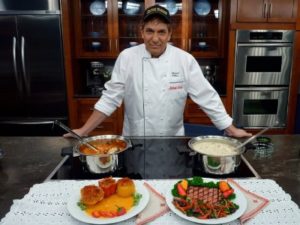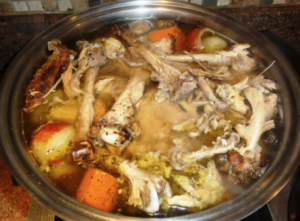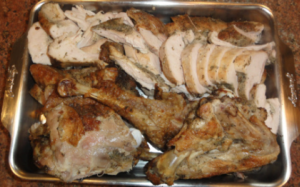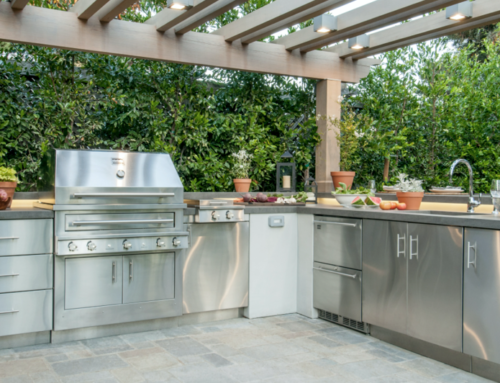 Why Roast Your Turkey Whole This Holiday? By: Chef Michael Niksic
Why Roast Your Turkey Whole This Holiday? By: Chef Michael Niksic
I have no good answer in favor or roasting it whole and I don’t recommend it.
Here is why:
1st things that hurt are the large amount of space & time a whole turkey takes up in the average home oven. Both will impair efficient production of the rest of the meal.
Why roast it whole? So Uncle Bob can try not to bleed this year while enacting the ceremonial carving job? While we are talking about this could someone please hide that “robe and tall paper chef hat” he covets and wears? Odds are he is not too good. Last time he carved anything it was probably a coupon from a paper! Now the turkey is most likely served cool to cold. The table is insanely crowded to accommodate the new urban renewal project taking place on the dinner table. There is more mess to deal with and less room to do it. Thanks Uncle Bob! Have another Peach Martini. Just moving a heavy bird in a hot roasting pan that has hot juice & oil in it in a kitchen of novices with probable counter/space issues makes no sense. The resistance to stopping this approach is fueled by not wanting to change anything. Change is bad! We always do it like this! By the way Uncle Bob you may want to stick that finger in the burner. I don’t think that’s cranberry sauce dude! Isn’t it about time for the annual family road trip to the ER? It’s comforting in an odd way to have the whole triage staff waiting at the door knowing Bob’s arrival is imminent.
When I was a kid I remember many people resisting this new appliance called an electric oven………….
 Roast the Turkey, cut up, the day before. It won’t be dry unless you overcook it. When the turkey is cut up like a sectioned chicken you can season it evenly and properly. There will be more brown caramelized exterior surface. The same part everyone duels for. It won’t take as long. You can more accurately roast each part of the bird when its cut up before cooking. You don’t blow away one section waiting for another to cook. Splitting the breast increases cooking speed and does nothing to affect moisture loss. You are creating more exterior surface by splitting it open. You are also adding more exterior surface to season. Roasting the turkey the day before allows easy containment of the mess created while handling the bird. It also allows you to pull the bones that you just roasted and make a killer stock. A great stock makes a great sauce, stuffing and the proper au jus necessary to reheat the turkey. Never stuff the bird. The internal temperature combined with the bread, eggs, cheese. Vegetables, nuts and any combination of them is perfect for salmonella to grow at an incredible rate and can sicken the elderly, infants and anyone with a weak immune system.
Roast the Turkey, cut up, the day before. It won’t be dry unless you overcook it. When the turkey is cut up like a sectioned chicken you can season it evenly and properly. There will be more brown caramelized exterior surface. The same part everyone duels for. It won’t take as long. You can more accurately roast each part of the bird when its cut up before cooking. You don’t blow away one section waiting for another to cook. Splitting the breast increases cooking speed and does nothing to affect moisture loss. You are creating more exterior surface by splitting it open. You are also adding more exterior surface to season. Roasting the turkey the day before allows easy containment of the mess created while handling the bird. It also allows you to pull the bones that you just roasted and make a killer stock. A great stock makes a great sauce, stuffing and the proper au jus necessary to reheat the turkey. Never stuff the bird. The internal temperature combined with the bread, eggs, cheese. Vegetables, nuts and any combination of them is perfect for salmonella to grow at an incredible rate and can sicken the elderly, infants and anyone with a weak immune system.
To make a good stock you will need to simmer the bones for about 2+hours. Adding some chicken bones will make a stronger stock and not over power the turkey. Adding a carton of turkey or vegetable broth won’t hurt. Always lean toward quality broths and away from MSG & excessive sodium content. Use carrots, mushroom, onion & celery as your core vegetables for your stock. Always add garlic if used near the end of the cooking of the stock. Seasonings if used can be added in the last 20-30 minutes. Don’t stir the bones once you start. Starting with cold water can help make a clearer stock but its not mandatory. Cut the vegetables an inch or two in size to make them less prone to dissolving and flaking apart from cooking for so long. This also helps make a cleaner stock. It’s important because the more you reduce a stock that is poorly made the more pronounced all the flavors in it become. Adding only a couple pieces of onion skin can help filter the stock. The exterior of the peel gets sticky when simmered at length and floating small pieces of (anything) will more often stick to it than not.
Use corn starch to thicken your sauce or gravy. Using flour will manifest a dull flavor with your final sauce. Cornstarch will cook “cleaner/clearer” so your taste buds are not impaired when in touch with it. The flour will be very effective clogging the pores of your tongue making it harder to discern flavors, especially salt. If you feel salt is a flavor that is also a need of modification:) Salt is an enhancer. It enhances your ability to taste other flavors more effectively and more efficiently. With the stock finished the day before the day OF becomes so much easier to serve, and more importantly ENJOY!
 Brushing the outside of the bird with a thin layer of oil makes for a crisper skin. The nature of turkey skin to remain crisp from roasting = short life span for that characteristic. So that argument against reheating isn’t really pertinent. Plus the meat exposed and roasted crisp does hold up well. Roasting should take place at around 375 degrees and the pieces when roasted separately need be turned over to brown more evenly. Length of roast time has many variables so your fall back is always an internal temperature of 165 degrees for all of the pieces. Convection ovens generally roast more evenly than conventional ovens. Don’t fear turkey slightly under cooked or just finished by a hair at 165 but looks too “pink”. You are reheating it in its own broth so repeat to 165 throughout on game day. Store over night at 40 degrees or colder and covered. Avoid aluminum foil touching your food. Use baking paper between your food and the foil to avoid touching. Ingesting any amounts of aluminum is not a good idea.
Brushing the outside of the bird with a thin layer of oil makes for a crisper skin. The nature of turkey skin to remain crisp from roasting = short life span for that characteristic. So that argument against reheating isn’t really pertinent. Plus the meat exposed and roasted crisp does hold up well. Roasting should take place at around 375 degrees and the pieces when roasted separately need be turned over to brown more evenly. Length of roast time has many variables so your fall back is always an internal temperature of 165 degrees for all of the pieces. Convection ovens generally roast more evenly than conventional ovens. Don’t fear turkey slightly under cooked or just finished by a hair at 165 but looks too “pink”. You are reheating it in its own broth so repeat to 165 throughout on game day. Store over night at 40 degrees or colder and covered. Avoid aluminum foil touching your food. Use baking paper between your food and the foil to avoid touching. Ingesting any amounts of aluminum is not a good idea.
One last note always wipe down the entire kitchen with a clean towel dipped in a solution of 2 Tablespoons of bleach and 1 quart of water. That should kill most any bacteria it touches so make sure handles, knobs, touch screens & faucets are on your short list.
The Food Mercenary
Chef Michael Niksic
FreeCookingPrograms.com


















